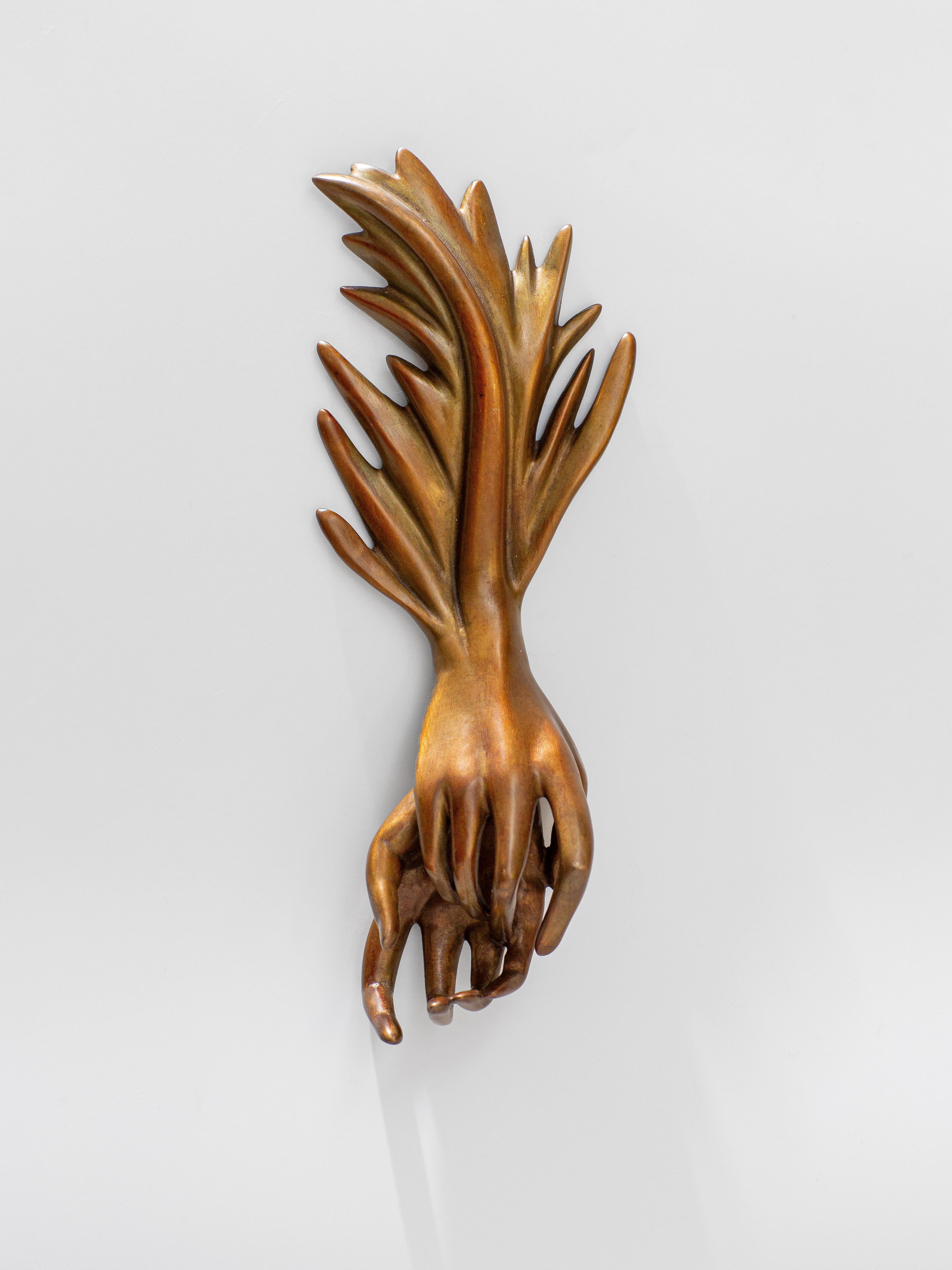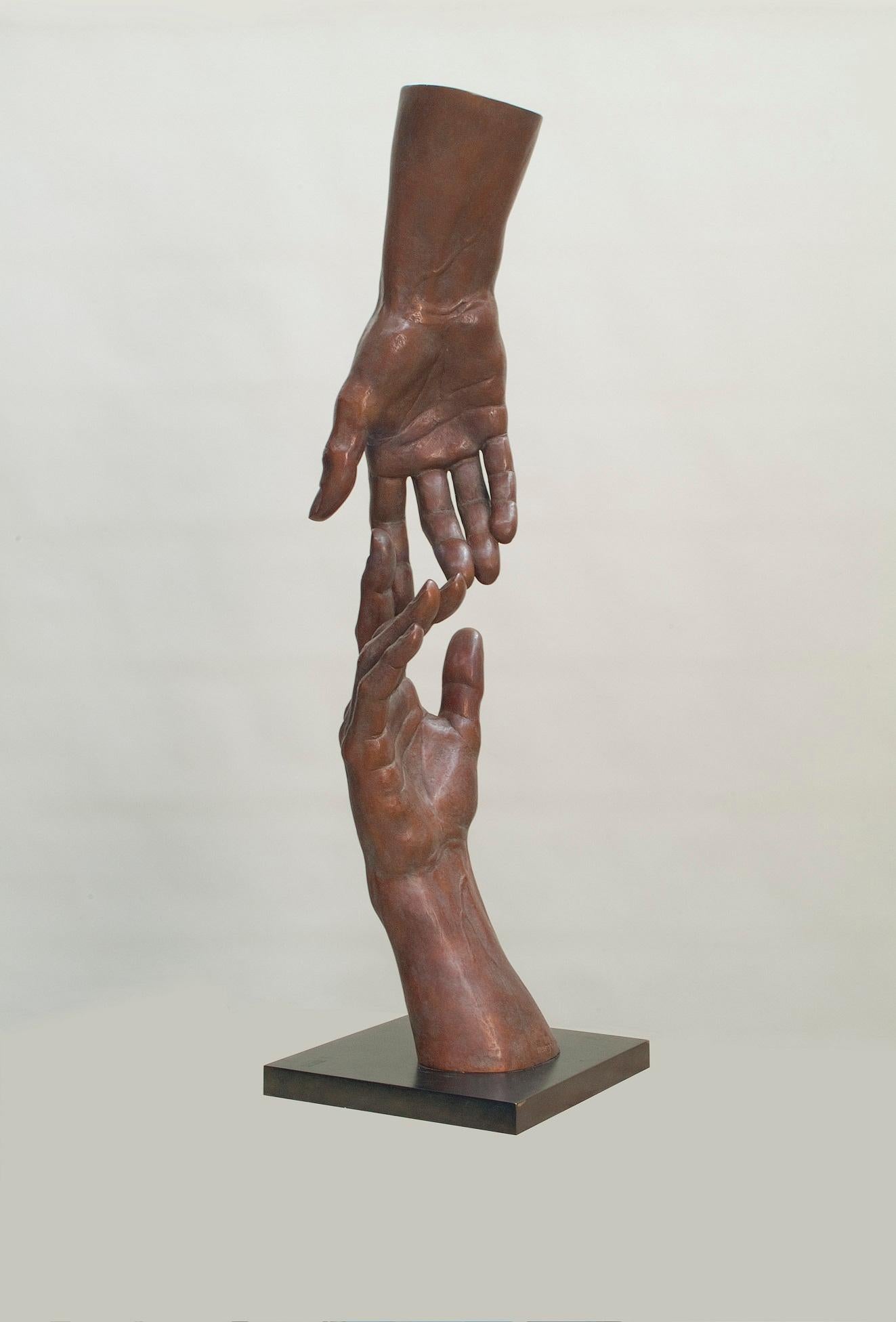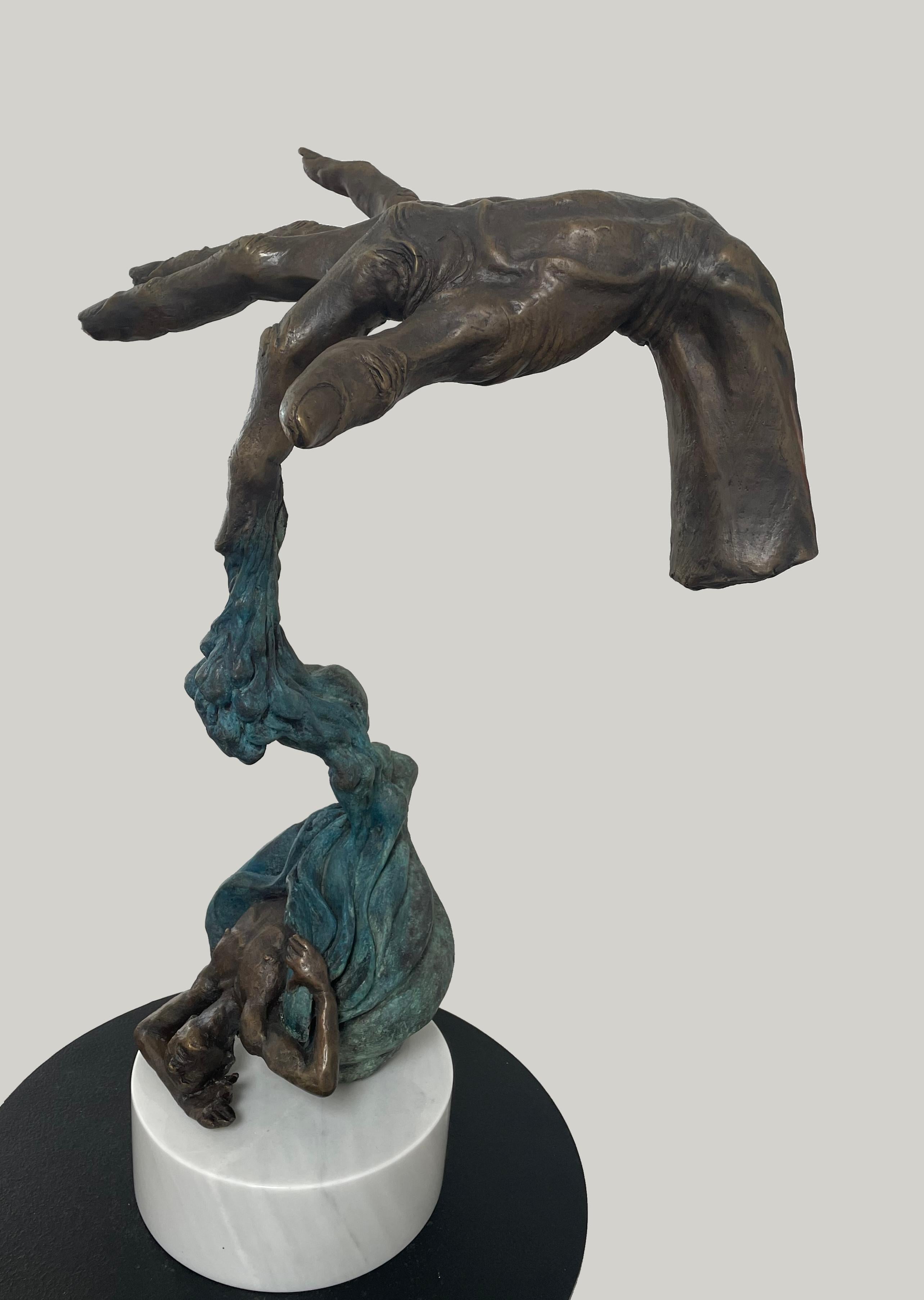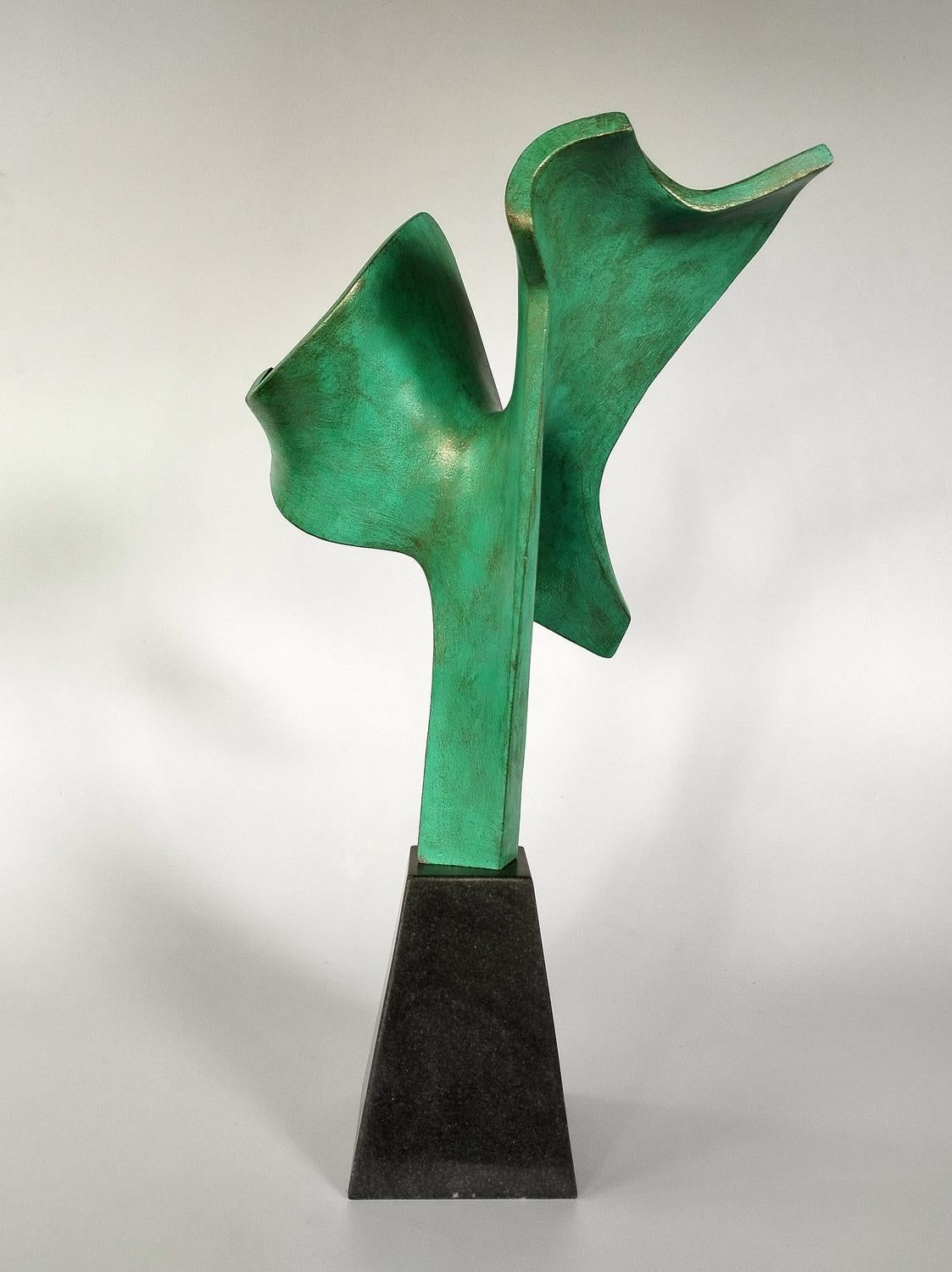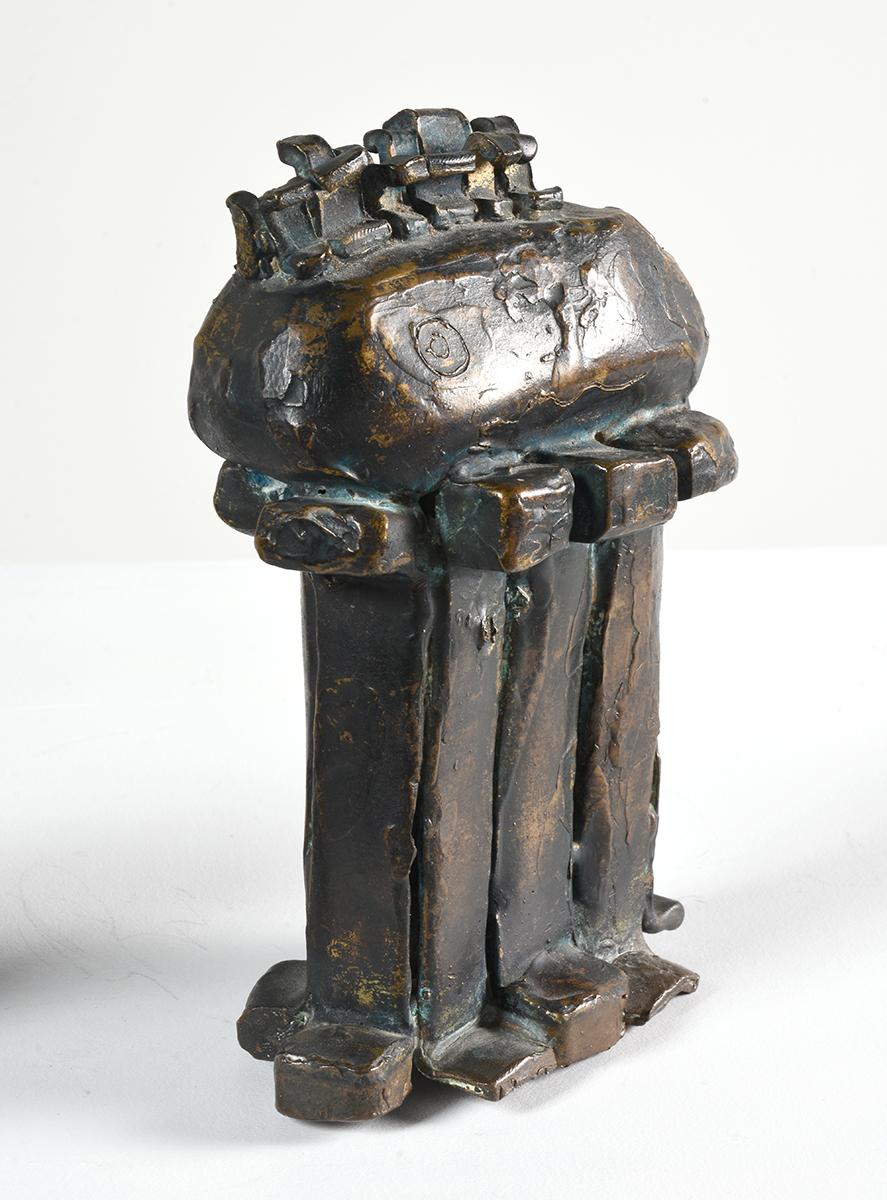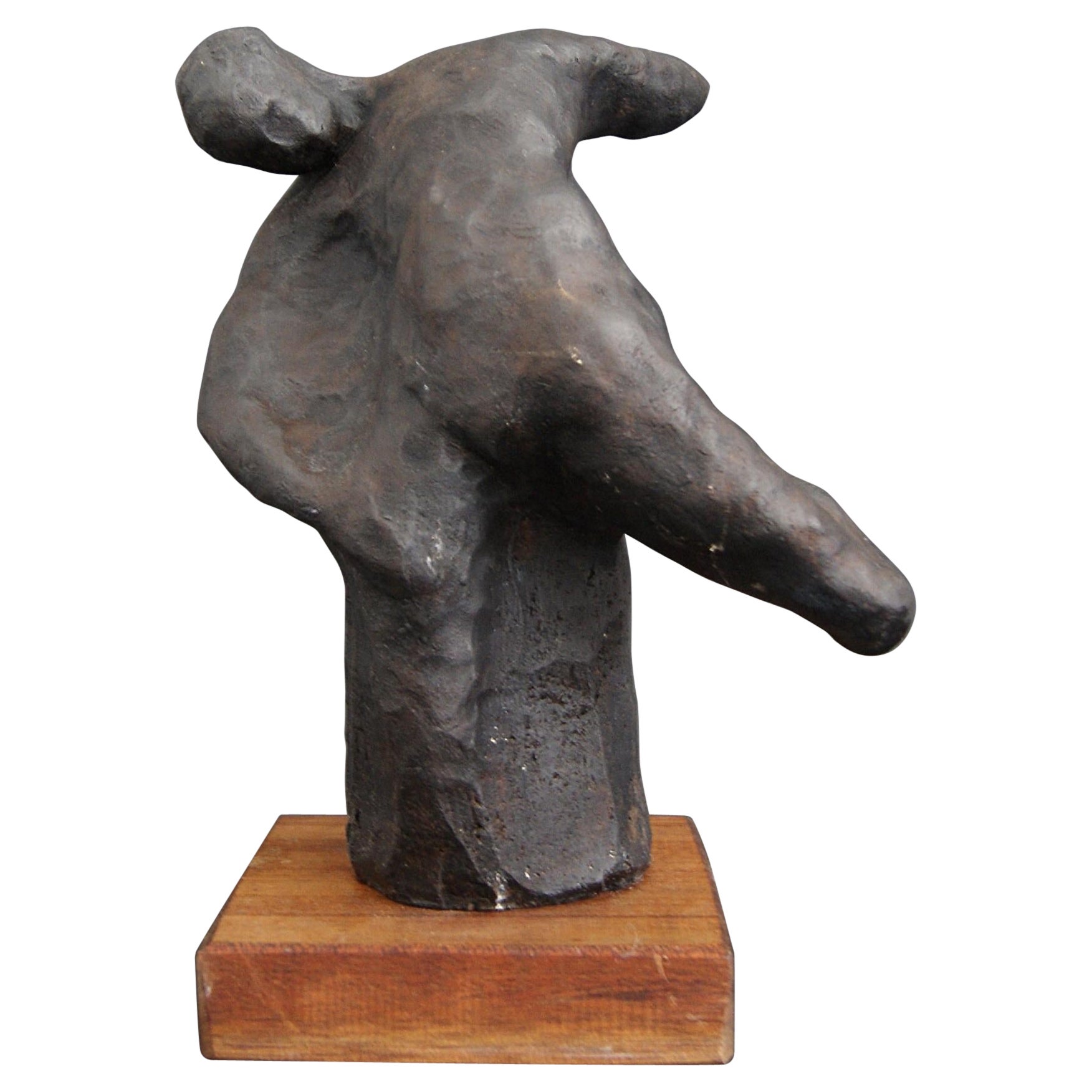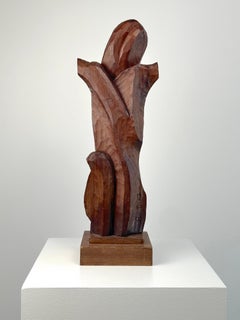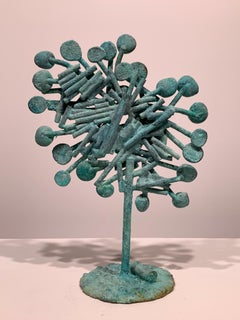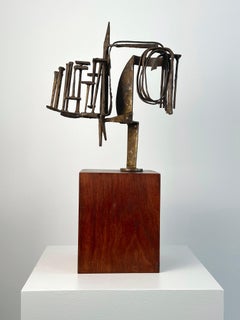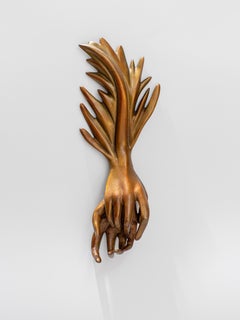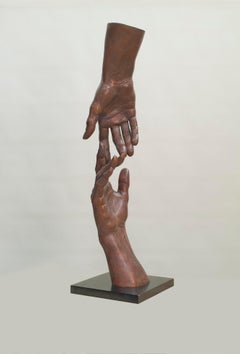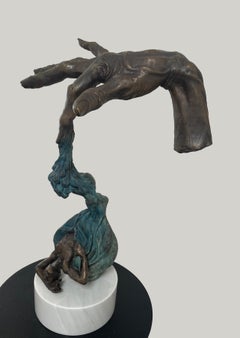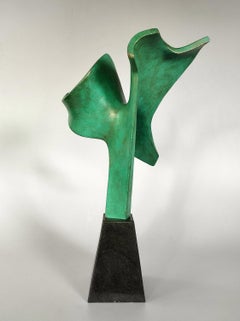Items Similar to Reaching (bronze hand)
Want more images or videos?
Request additional images or videos from the seller
1 of 10
James E. LewisReaching (bronze hand)ca. 1980
ca. 1980
$4,000
$5,00020% Off
£3,006.94
£3,758.6820% Off
€3,486
€4,357.5020% Off
CA$5,584.62
CA$6,980.7820% Off
A$6,255.07
A$7,818.8420% Off
CHF 3,254.72
CHF 4,068.4020% Off
MX$75,967.42
MX$94,959.2720% Off
NOK 41,261.61
NOK 51,577.0120% Off
SEK 38,933.40
SEK 48,666.7520% Off
DKK 26,010.53
DKK 32,513.1620% Off
Shipping
Retrieving quote...The 1stDibs Promise:
Authenticity Guarantee,
Money-Back Guarantee,
24-Hour Cancellation
About the Item
Reaching, ca. 1980. Cast bronze. Signed in lower region on wrist.
A rare example from the artist's later period influenced by figurative abstraction with expressionist tendencies.
James Edward Lewis (August 4, 1923 – August 9, 1997) was an African-American artist, art collector, professor, and curator in the city of Baltimore. He is best known for his role as the leading force for the creation of the James E. Lewis Museum of Art, an institution of the HBCU Morgan State University. His work as the chairman of the Morgan Art Department from 1950 to 1986 allowed for the museum to amass a large collection of more than 3,000 works, predominantly of African and African diasporan art.[1] In addition, he is also well known for his role as an interdisciplinary artist, primarily focused on sculpture, though also having notable examples of lithography and illustration. His artistic style throughout the years has developed from an earlier focus on African-American history and historical figures, for which he is most notable as an artist, to a more contemporary style of African-inspired abstract expressionism.
Early and personal life
James E. Lewis was born in rural Phenix, Virginia on August 4, 1923 to James T. Lewis and Pearline (Pearlean) Harvey.[5] Lewis' parents were both sharecroppers. Shortly after his birth, his father moved to Baltimore for increased job opportunity; James E. was subsequently raised by his mother until the family was reunited in 1925. They lived for a short time with distant relatives until moving to a four-bedroom house on 1024 North Durham Street in East Baltimore, a predominantly African-American lower-class neighborhood close to Johns Hopkins Hospital. Lewis' primary school, PS 101, was the only public school in East Baltimore that served black children. Lewis grew up in a church-going family, his parents both active members of the Faith Baptist Church, devoting the entirety of their Sundays to church activities. His parents worked a variety of different jobs throughout his youth:[6] his father working as a stevedore for a shipping company, a mechanic, a custodian, a mailroom handler,[6] and an elevator operator.] His mother worked as both a clerk at a drugstore[7] and a laundress for a private family.[4]
Lewis' primary exposure to the arts came from Dr. Leon Winslow, a faculty member at PS 101 who Lewis saw as "providing encouragement and art materials to those who wanted and needed it." In fifth grade, Lewis transferred to PS 102. Here, he was able to receive specialized Art Education in Ms. William's class under the guidance of Winslow. He was considered a standout pupil at PS 102 as a result of his introduction to the connection between the arts and the other studies. His time spent in Ms. Pauline Wharton's class allowed for him to experiment with singing, to which he was considered a talented singer. His involvement in this class challenged his earlier belief that singing was not a masculine artistic pursuit. He was able to study both European classics and negro spirituals, which was one of his earliest introductions to arts specific to American black culture. Under Ms. Wharton's direction, he was also involved in many different musical performances,[6] including some works of the Works Progress Administration's Federal Theatre Project.[8] Lewis attended Paul Laurence Dunbar High School, where his love of the arts was heightened through his industrial art class with Lee Davis, who instilled in him a care for fine craftsmanship.[6] At age sixteen, Lewis had won a citywide poster design contest, and later had the work displayed at the Enoch Pratt Free Library. He produced his first sculpture at age 17 out of earthen clay from the East Monument Street fairgrounds.[9] He was personally very close with the school faculty, often going over to Davis' house to listen to jazz music or visiting Dr. Winslow and his children. The connection he had with the Winslow family solidified his interest in pursuing fine art after high school.[6] By age 19, he had produced five completed portrait busts.[9] While still in high school, Lewis had been awarded a Carnegie Institute grant to study at the Maryland Institute College of Art, but the school was highly segregated at the time and thus he was prohibited from attending.[6] Luckily, a compromise was made with the school to allow an advanced student, American artist Charles Cross, to tutor him in private sessions.[8] He graduated from Dunbar High with the highest average in the arts.
Pearline was supportive of her son's desire to pursue a career in the arts, but her husband felt the opposite, believing that his son should make an honest living through manual labor. As a result, James E. Lewis opted to work at the Baltimore Calvert distillery during the summer following graduation,[6] beginning on the 30th of June of that year. Having just graduated and now a young adult, Lewis registered for the Selective Service System.[3] During this time, a legal loophole was created that allowed for African-Americans in Maryland to study at any college of their choice with tuition, travel, and room & board covered by the state, so long as they intended to study a field that had no current representation in any of the black schools they were allowed to attend. Lewis, seeing this law as a form of "poetic justice", decided to apply to study fine art at Philadelphia College of Art, now called the University of the Arts. Lewis studied for a year at PCA before receiving a letter in the mail from the United States Armed Forces stating that he had been drafted into World War II.
Lewis had been drafted into the United States Navy, but soon after joined the United States Marine Corps due to a new policy that allowed for black recruits, something which he saw as both progress and a personal challenge. He was stationed at Camp Lejeune in Jacksonville, North Carolina, traveling there with his fellow Marines in a segregated train car. At the camp, the segregation further continued, with the black soldiers living in makeshift huts and their white counterparts living in brick buildings. In 1943, he received notice of his father's passing, and returned home for the funeral. Shortly after the services, he returned to camp, something which he regretted in hindsight after finding out he could have been discharged, as he was his mother's sole source of financial support. He returned to discover that many of his unit members had been shipped out to the front lines in the Pacific. He heard stories of black soldiers being sent out with no weapons and so he had himself transferred to the 51st Defense Battalion, the first black fighting unit of the Marine Corp. Given the prevalence of racial discrimination in the United States military and the skill of the battalion, Lewis claimed that they were shipped out to Easter Island to keep them away from the action and preserve the image of the white Marines. He served a short stint in gunnery and intelligence before leaving the military in 1946.[6]
James E. Lewis returned to Philadelphia College of Art and received a Bachelor of Fine Arts in 1949.[2] During this time, he met and married his wife,[6] Jacqueline Lucille Adams.[10] Lewis planned on having a career solely in illustration, but realized that the field was not welcoming to African-Americans.[6] The Philadelphia College of Art offered him a position as a drawing instructor, and so he worked there for a short time.[8] He received an offer to teach at Morgan State University not long after this but refused the position, instead choosing to use the G.I. Bill to stay in Philadelphia and attend the Tyler School of Art at Temple University.[6] He received his Master of Fine Arts from Temple in 1950.[2] After graduating, he was offered a teaching position at Jackson State Teachers' College and accepted. Three days before his planned arrival in Jackson, Mississippi, he received a call from Martin David Jenkins with another offer to teach at Morgan State. Lewis changed his mind and took the Morgan position, settling back in Baltimore with his wife.[6]
Lewis was also a personal collector of art. He once cancelled a vacation because he ended up spending all the funds on purchasing a Henry Ossawa Tanner work in New York.[1] He was also known to have collected the works of his students, buying them to inspire them to keep producing art.[11]
He was known to have spoken with Martin Luther King Jr. prior to King's death. Lewis was a strong supporter of placing a bust in the United States Capitol, and was one of the first to lobby for it.[12]
Lewis and Adams had two children together, Cathleen Susan Tamberg (born March 17, 1958)[10] and James Edward Lewis Jr.
James E. Lewis died of stroke complications on August 9, 1997, at Genesis Nursing Home in Baltimore. He was 74 years old.[11]
Academic career
Morgan State educator
At the start of his career, Lewis was part of a three-person art department, including himself, Charles Stallings, and Samella Lewis. Samella Lewis was on leave at the start of his position, and she left shortly after his promotion to chairman at the end of the year. He chose to restructure the department in 1951, and created the program that grants bachelor's degrees in art education.[6] Lewis' role as an art collector on behalf of Morgan State began in 1952 with the purchase of five works of African art for $595.[13] Sometime in the early 1950s, Lewis also introduced the first courses on African and African-American art.[9] In 1954, he was awarded the Ford Foundation Fellowship to study as a fellow at various different institutions.[6] He was a fellow at Temple University and Syracuse University in 1954 and Yale University in 1955.[2] It was during his time at Yale that he was working directly under the great Bauhaus artist Josef Albers, who "shook up" what Lewis previously knew about art. It was Albers who inspired Lewis to seek motifs from traditional African art for his own work. Around this time, Lewis received a letter from his former mentor, Charles Cross, who sought a position in the department, though Cross didn't end up working there.[6]
Lewis, on behalf of Morgan State University, was awarded a $5,000 grant from the American Federation of Arts to add works to the university's collection, the first award the arts department had received for its gallery. Shortly after they were purchased, however, three works were stolen from the collection while Lewis was working to find a permanent location to display them.[9] In 1964, he made a visit to galleries in New York City, one of which was the Hirschl & Adler Galleries,[1] which later gifted the museum thirty-five works of European and American importance.[9] Lewis was working on curating an exhibition at Morgan's art galleries at the time, one of the most influential shows of his career, entitled "The Calculated Image".[13]
In March 1969, Lewis took a trip to Europe. While in Paris, Lewis saw the works of Bill Hutson, Sam Middleton, and Edward Clark at the American Center for Students and Artists, as well as some work by Beauford Delaney at the United States Information Center. Afterward, he visited the Galerie Dürr in Munich to see the work of Lawrence Compton Kolawole.[14] Inspired by the success that these artists (as well as Dean Dixon[15]) had abroad, he secured a grant from the Smithsonian Institution to do a study on African-American artists who have moved abroad to pursue their artistic careers the following year. He conducted his study on the aforementioned visual artists with the additions of Herbert Gentry, William Johnson, Jacob Lawrence, and Henry Ossawa Tanner. Using this information, he guest-curated a show of the works of those artists entitled "Afro American Artists Abroad" at the University of Texas at Austin.[14] He also was a guest-curator at the Baltimore Museum of Art in primitive art.[9]
On December 9, 1990, the Murphy Fine Art Galleries were officially renamed to the James E. Lewis Museum of Art in his honor. An official dedication exhibition was held to celebrate his commitment to education and African-American art. Many artists donated works to the museum to celebrate its renaming, including Gordon Parks, Sam Gilliam, Grace Hartigan, Joyce J. Scott, Jack White, and Joan Erbe. Aaron Sopher also made an original illustration of Lewis for the museum.[13] During his time at MSU, Lewis was able to collect over 3,000 works for the museum. Some of the artists represented in the museum's collection as a result of Lewis' collecting efforts include Hale Woodruff, Romare Bearden, Henri de Toulouse-Lautrec, Thomas Cole, Mary Cassatt, Robert Rauschenberg,[1] and Pablo Picasso.[13]
Archaeological digs
Lewis began visiting Africa originally to collect works of art for JELMA. He gave lectures at different West African universities for the American Society of African Culture in 1965,[6] one of which was Ahmadu Bello University in Zaria, Nigeria. He became area director of the ASAC the following year.[6] During his visit, he met Epko O. Eyo, the director of antiquities of Nigeria while spending time in the city of Lagos.[16] While in Africa, he was also the organizer of the Dakar Arts Festival.[8] In 1965, at the recommendation of Eyo, Lewis returned to Nigeria to Owo[6] to join a fourteen-person party on an archaeological excavation.[16] This dig was his third trip to Nigeria and his seventh to Africa. The group labored in over 100 °F (38 °C) heat to excavate,[17] work that uncovered thousands of terracotta artifacts and fragments.[16] Lewis estimated that some of the items found at Owo, such as a leopard figure, were valued at over $100,000.[17] Lewis returned twice after this to continue the search.[18] Some of the oldest works from the site are dated to around the 12th century.[6] These finds were significant in that they identified a cultural connection between ancient Ifẹ and Benin societies, visible through the similarities to both of their works.[18] Lewis made 15 trips to Africa in his life, most of which were on behalf of the United States Information Agency.[11]
Lewis also did some archaeological work in Israel.[13]
Organizations
Lewis was a member of a number of different organizations. In 1962, he was appointed to the Maryland Fine Art Commission by Governor J. Millard Tawes. In addition to this, he was a member of the Baltimore City Commission for Historical and Architectural Preservation, the American Society of African Culture, the College Art Association, the Eastern Art Association, the American Federation of Arts, the Maryland Art Association, and the American Association of Museums.[2] He was also a founding member of the Baltimore Council on Foreign Relations.[19] Lewis also worked briefly with the Baltimore Symphony Orchestra.[11]
Artistic career
James E. Lewis was heavily inspired by the history and culture of African-Americans and Africa. Lewis once said, "We need to be more supportive of our unique cultural heritage and its arts."[19] One such example of his inspirations were gold weights of the Ashanti people.[6] Another major influence for him were the masks of the Senufo culture.[20] Lewis cited his success as a result of his capability to express himself within the limitation of a predominantly white art world.[8] His primary means of gaining acceptance for his works were to create sculptures in a Western naturalistic or abstract expressionist style.[2] He once said, "Had I gone in to meetings with their committee looking exotic in a dashiki and all the trappings worn by the young black activists who have knowledge of African aesthetic, my ideas would have been promptly rejected. But they accepted what I proposed because it seemed to them that I myself was quite within their norm, and they assumed that what I was proposing had to be sound, whether they fully understood it or not." He became the most comfortable with producing three-dimensional works during his first few years at MSU, referring to it as his métier, working on them whatever chance he got.[6] His daughter said that he often would go nights without sleep to keep working on his art.[11] Many of his works have been described as "socially charged".[21]
- Creator:James E. Lewis (1923 - 1997)
- Creation Year:ca. 1980
- Dimensions:Height: 9 in (22.86 cm)Width: 3 in (7.62 cm)Depth: 5.5 in (13.97 cm)
- Medium:
- Movement & Style:
- Period:
- Condition:
- Gallery Location:Wilton Manors, FL
- Reference Number:1stDibs: LU245214300952
About the Seller
4.9
Platinum Seller
Premium sellers with a 4.7+ rating and 24-hour response times
Established in 2007
1stDibs seller since 2015
410 sales on 1stDibs
Typical response time: 3 hours
- ShippingRetrieving quote...Shipping from: Wilton Manors, FL
- Return Policy
Authenticity Guarantee
In the unlikely event there’s an issue with an item’s authenticity, contact us within 1 year for a full refund. DetailsMoney-Back Guarantee
If your item is not as described, is damaged in transit, or does not arrive, contact us within 7 days for a full refund. Details24-Hour Cancellation
You have a 24-hour grace period in which to reconsider your purchase, with no questions asked.Vetted Professional Sellers
Our world-class sellers must adhere to strict standards for service and quality, maintaining the integrity of our listings.Price-Match Guarantee
If you find that a seller listed the same item for a lower price elsewhere, we’ll match it.Trusted Global Delivery
Our best-in-class carrier network provides specialized shipping options worldwide, including custom delivery.More From This Seller
View AllAbstract Figure
By Raul Diaz
Located in Wilton Manors, FL
Raul Diaz (Argentina, b.1950). Abstract Figure, ca. 1970s. Canved Walnut. Measures 17 inches tall including wood base. Carved signature in lower region. Excellent condition.
An ear...
Category
1970s Abstract Expressionist Abstract Sculptures
Materials
Walnut
$1,200
Untitled abstract expressionist mid-century modern sculpture
By Thomas Morin
Located in Wilton Manors, FL
Thomas Morin (1934-2017)
Untitled, 1962.
Cast iron on wood base. Cast sculpture measures 24 x 7 x 5 inches and weighs 49 lbs. Overall measures 26 inches tall on wood base.
Proc...
Category
Mid-20th Century Abstract Expressionist Abstract Sculptures
Materials
Iron
Untitled (Organic abstract bronze sculpture)
Located in Wilton Manors, FL
Klaus Ihlenfeld (b.1934). Untitled, ca. 1960. Welded bronze. 8" h.; 5.5 " w; 3.25" d (base). Signed with initial under base.
Provenance: Directly from estate of Harry Bertoia. The piece was a gift from Ihlenfeld and is a very early example created during Bertoia apprenticeship era.
Excellent condition.
Klaus Karl Otto IhlenfeldHe was born in Berlin, Germany in 1934. He studied art at the Hochschule für Bildende Künste and completed graduate work with the metal sculptor Hans Uhlmann. He visited the US in 1957 for the first time living in Durham, NC, where he befriended Dr. W. R. Valentiner, the Rembrandt authority and Director of the Museum of Art, Raleigh, NC. Through this friendship in 1960 he met and worked with the metal sculptor Harry Bertoia in Barto, PA.
He joined the Staempfli Gallery in NYC and entered in many group and one-man shows. He has been an Artist-in-Residence in Ogden, Utah; Huntington Museum of Art in West Virginia, Penn State University at University Park; the Colorado State University in Denver; and Shippensburg University. He has large commissions at Kutztown University, Pottstown Hospital, and a monumental relief sculpture at the Emigrant Savings Bank in NYC. He has traveled extensively in Spain, Greece, and Mexico. He is living and working on a farm in Barto, PA welding bronze and forged iron metal sculptures and painting watercolors.
Group Shows:
North Carolina Museum of Art in Raleigh, NC - 1957
Solomon R. Guggenheim Museum in New York City - 1962
Staempfli Gallery in New York City - 1962, 1964 and 1965
Gallery Ludwig Lange in West Berlin, Germany - 1977
Gallery Herbert Remmert and Dr. Barth in Dusseldorf in West Germany - 1981
Jack Savitt Gallery in Macungie, PA - 1981 and 1984
Heinz Ortleb Gallery, West Berlin, Germany - 1992
Central Bucks Chamber of Commerce Show at the James A. Michener Art Museum in Doylestown, PA - 1997
Berks Art Alliance Show at the Reading Art Museum in Reading, PA - 1997
Mayfair Festival of the Arts at the Allentown Art Museum - 1998
Baum School of Art in Allentown, PA - 1997
Schwenkfelder Library and Heritage Center Art Show in Pennsburg, PA - 2001
Reading Public Museum in Reading PA, 2014
Solo Shows:
Kutztown University in Kutztown, PA - 1960 and 1965
Allentown Art Museum in Allentown, PA - 1960 and 1961
Staempfli Gallery in New York City - 1962
Penn State University in University Park, PA - 1964 and 1972
Berks Art Alliance in Wyomissing, PA - 1966
Bertha Eccles Art Center in Ogden, Utah - 1967
Mansfield University in Mansfield, PA - 1967
Huntington Museum of Art in Huntington, WV - 1971
Shippensburg University in Shippensburg, PA - 1972
Albright College in Reading, PA - 1973
Ianuzzi Gallery in Scottsdale, AZ - 1974
Gallery Heimat 85 in West Berlin, Germany - 1977
Jack Savitt Gallery in Macungie, PA - 1981
College Misericordia in Dallas, PA - 1983
Schwenkfelder Library and Heritage Center in Pennsburg, PA, 2013
Periodical Reference:
Kaye, Ellen "The Obsessive Collector," Philadelphia Inquirer Sunday Magazine Sptember 21, 1986 pp. 32-33.
Chronology:
1-30-1934 Born in Berlin, Germany. Father, Kurt Ihlenfeld, Lutheran pastor, novelist, critic and publisher was born in 1901 in Colmar, Alsace Lorain. Mother, Annie Stuhlmann, was born in 1905 in Breslau, Lower Silesia.
1940 - 1950 Public schools in Berlin; Löwen, Lower Silesia; Coswig, Radebeul, Glaubitz, Saxony. Königin Luise-Gymnasium in Dahlem, Berlin. First artworks, drawings and paintings; few sculptures.
1950 - 1956 Studied at the Hochschule für Bildende Künste in West Berlin, Germany. Graduate work with metal sculptor Hans Uhlmann. For 2 years maintained own studio at the Academy. Friendship with writer Günter Grass, and painter F. S. Sonnenstern. Met painters: Max Pechstein, Karl Schmidt-Rottluff, Carl Hofer, Max Kaus, and sculptors: Bernhard Heiliger, Renee Sintenis, and Richard Scheibe...
Category
Mid-20th Century Abstract Abstract Sculptures
Materials
Bronze
$5,000 Sale Price
37% Off
Banner (abstract expressionist sculpture, Tulsa OK artist)
Located in Wilton Manors, FL
Duayne Hatchett ((1925-2015). Banner, 1958. Welded metal, sculpture measures 11 h. x 9 w. x 3.75 d. inches. Measuring a total of 17.5 inch high on base. Base measures 5.5 x 5.5 by 6 ...
Category
Mid-20th Century Abstract Expressionist Abstract Sculptures
Materials
Metal
$6,000 Sale Price
25% Off
Nexus
By Jack Youngerman
Located in Wilton Manors, FL
Abstract sculpture by American artist, Jack Youngerman (b.1926). Nexus, 1990. 24.5 inches. Aluminum, numbered 2/3. Signed and numbered on base.
1926 Born, St. Louis, Missouri; moved with family to Louisville, Kentucky in 1929
1943-44; 1946-47 Attended University of Missouri
1944-46 U.S. Navy, University of North Carolina
1947-49 Ecole des Beaux-Arts, Paris
1949-55 Lived and worked in Paris
1956 Returned to the United States; lived in New York City 1956-1995
1995-current Resides in Bridgehampton, New York
ONE MAN EXHIBITIONS:
1951 Galerie Arnaud, Paris
1958 Betty Parsons Gallery, New York (1960, 1961, 1964, 1967, 1968)
1959 Museum of Modern Art, New York, "Sixteen Americans"
1962 Galerie Lawrence, Paris (also 1965)
1963 Galeria dell' Ariete, Milan
Everett Ellen Gallery, Los Angeles, California
The Phillips Collection, Washington, D. C.
1971 Pace Gallery, New York (also 1972, 1975)
1972 Portland Center for the Arts, Oregon
Seattle Art Museum, Washington
1973 The Arts Club of Chicago, Illinois
Galerie Denise Rene, Paris
1975 Hopkins Center, Dartmouth College, Hanover, New Hampshire
1976 Parrish Art Museum, Southampton, New York
1981 Washburn Gallery...
Category
1980s Abstract Abstract Sculptures
Materials
Aluminum
$4,500 Sale Price
30% Off
Greek Guitar Player
Located in Wilton Manors, FL
Beautiful abstract sculpture depicting a guitar player. Bronze on wood base measuring 15 x 9 x 4 inches. Actual cast piece without base measuring 17 x 7 x 3 inches. Signed indistinct...
Category
Mid-20th Century Abstract Abstract Sculptures
Materials
Bronze
$900 Sale Price
25% Off
You May Also Like
Touched, 2023, Bronze, edition of 10, Cuffed Series, Hand Sculptures
Located in New York, NY
Artist Statement:
#1 My hands reach, touch, and shape.
Hands let go and receive; they try to hold things and to hold things together. Some of my images of hands are derived from M...
Category
2010s Abstract Abstract Sculptures
Materials
Bronze
Origin of the Question II Bronze Sculpture Hands Contemporary Classic Mythology
By Margot Homan
Located in Utrecht, NL
Origin of the Question Bronze Sculpture Hands Contemporary Classic Mythology
The sculptures of Margot Homan (1956, Oss, the Netherlands) show a perfect command of the old craft of m...
Category
21st Century and Contemporary Contemporary Figurative Sculptures
Materials
Bronze
The Hand of Creation
Located in Culver City, CA
The Hand of Creation is double life-sized; four times the mass of a human hand. Sherman desired to make a hand that expresses gentility, wisdom, and beauty. He chose a woman's hand a...
Category
1990s Still-life Sculptures
Materials
Bronze
"Receiving (24-inch)" abstract bronze sculpture
Located in Glen Ellen, CA
Cast bronze sculpture with classic green patina on black marble base. Edition of 3 at this size. Other sizes and patina finishes are also available by commission, please inquire for more details.
Pisapia's "Expedition Series," inspired by sea voyages, is about meeting life’s challenges with courage and purpose. It connects to the idea expressed by J.W. Goethe: “Character is formed in the stormy billows of the world.” Taking up life’s tasks can require one to go against the wind. The feeling of determination to achieve and continue steering through obstacles is poured into the pure forms; a dynamic balancing of the straight and curve on different axes. "With a rounded starting point," Pisapia explains, "I add on a variety of disparate angles, diverse curves, and twisting planes. I carve and smooth the surfaces, bringing out particular tensions and transitions."
Flavius Valone Pisapia is an Italian-Romanian artist born in Bucharest in 1981. He completed his higher education in the UK, with an MA in Transpersonal Arts & Therapy, 2014; a Diploma in Transformative Arts, 2011; and a BA (Hons) in Film and Video, 2005. Pisapia studied sculpture throughout his higher education and appreciated several sculptor mentors in the UK. Since 2016, he has resided in India, where he is currently an artist in residence at Studio Sukriti in Jaipur. He has had several solo exhibitions in India and his artwork is found in private collections worldwide.
"It's important for me to experience the world at a deeper level by penetrating the veil of the senses. Through an immersive process the essence, beauty and the pure form of an idea are gradually revealed to me. The emerging awareness flows into my artwork imbuing it with a higher reality. To achieve this awareness in my creative process, I go through three stages: imagination, inspiration and intuition." - Flavius Pisapia
Category
2010s Contemporary Abstract Sculptures
Materials
Bronze
Eugene Caples "Bronze Sculpture II" Abstract Bronze Sculpture
By Eugene Caples
Located in Detroit, MI
This small exquisite "Bronze Sculpture II" is in excellent condition and a perfect example of Eugene Caples craftsmanship. This is mainly abstract with some graphic or architectural elements and is so delightful that mythical creatures demand to be considered. It cries out to be touched and held, looked at and caressed. The beautiful patina on the surface gives voice to the many hands that have done these things.
Eugene Caples is a designer and craftsman who worked in Kansas City in the 1960s and later through the early 21st century. He attended the Kansas City Art Institute, earning his Bachelors of Fine Arts in Industrial Design in 1959. In 1963 he was accepted to Cranbrook Academy of Art, Bloomfield Hills, Michigan. The Cranbrook Academy of Art was designed by architect and faculty member, Eliel Saarinen who collaborated with Charles and Ray Eames on chair and furniture design. Numerous creative artists are alumni of Cranbrook and include: Harry Bertoia, Florence Knoll, Jack Lenor Larsen, Donald...
Category
Late 20th Century American Modern Abstract Sculptures
Materials
Bronze
Artist Plaster Sculpture Bronze Patina on a Wooden Base, Abstract Art
Located in Saarbruecken, DE
Hand-formed sculpture made of plaster of paris with patinated bronze on a wooden base. The plaster figure is from the German artist TADÄUS from the series formless body shapes from 2...
Category
21st Century and Contemporary German Organic Modern Abstract Sculptures
Materials
Plaster
More Ways To Browse
Paris Art Bronze
Family Bronze
Bronze Ship
Bronze Cross
Bronze Figural Groups
Bronze Artifacts
African Primitive Art
Portrait Bust Bronze
Bronze Age Antiquities
Large Bronze Cross
Bronze Soldier
Vintage Leopard Art
Nigeria Sculpture
Fairground Art
Clay Sculpture Abstract Mid Century
Vintage Elevator
Car Bronze Sculpture
Sleeping Bronze
